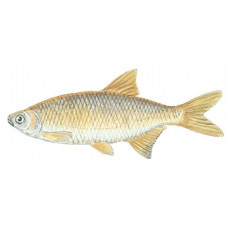Latin name
Notemigonus crysoleucas
Other names
No information
Identification
Minnows are characterized by a single dorsal fin, pelvic fins, soft fin rays, cycloid scales, and a set of bones that connect the inner ear to the swim bladder. This last feature, known as the Weber apparatus, enhances the minnows' ability to discriminate sounds. They have no teeth in their mouths; instead, they grind their food with pharyngeal teeth located in the throat. Males of many species have keratinized tubercles on their head, body, and fins. The tubercles may facilitate body contact during spawning or be used in aggressive interactions between males. Large tubercles are nicknamed "horned heads" by many anglers.
Distribution
No information
Habitat
The minnow's ecological habitat is as diverse as the family itself. Minnows can be found in streams, rivers, marshes, ponds, lakes, and reservoirs. However, most species of minnow live in flowing water and do not do well in reservoirs.
Size
The body size and lifespan of minnows vary widely. Adults of most minnows are less than 100 millimeters long and live from 2 to 5 years. One of the smallest species is the blackmouth shiner (Notropis melanostomus), which is less than 1.4 inches long. At the other end of the spectrum is North America's largest native minnow, the Colorado squawfish (Ptychocheilus lucius), which reaches nearly 6 feet in length and 99 pounds in weight. Minnows of this genus can live more than 10 years.
Life history and Behavior
Minnows exhibit a variety of life history signs. The breeding season may be as short as 1 month or as long as the entire year. Many species reproduce between March and August, probably because warmer water temperatures favor gamete formation and larval survival. Accordingly, the length of the breeding season tends to be longer in species from lower latitudes. There is considerable variation in reproductive behavior within the family.
Food and feeding habits
Minnows are extremely important ecologically. They carry energy through aquatic ecosystems by converting their detritus, algae, and microbial food into fish meat that larger fish can feed on. They are also an important food source for birds and other wildlife.
Reproduction
No information
| Classification | |
| Phylum | Chordata |
| Class | Actinopterygii |
| Squad | Cypriniformes |
| Family | Cyprinidae |
| Genus | Notemigonus |
| Species | N. crysoleucas |
| Features | |
| Conservation status | Least Concern |
| Habitat | Pelagic |
| Life span, years | 10 |
| Maximum body weight, kg | 45 |
| Maximum length, cm | 30 |
| Sailing speed, m/s | No information |
| Threat to people | Edible |
| Way of eating | Predator |
Minnow: Golden Shiner
Tags: Minnow: Golden Shiner


